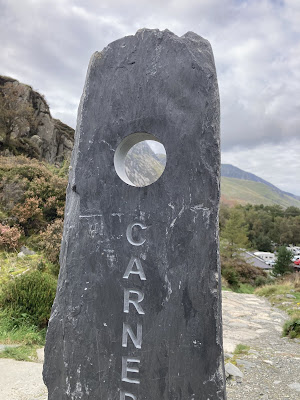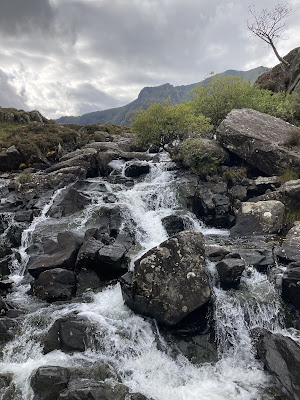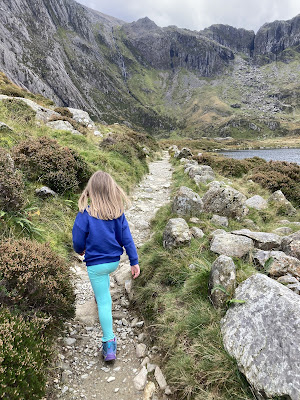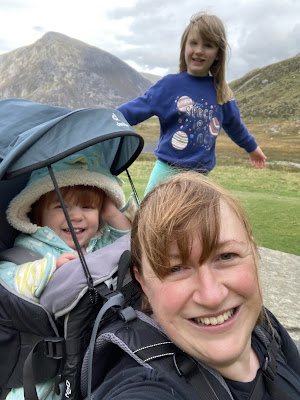
It’s been quite a while since my last proper walk. Went back to work in September after the summer holidays and so it’s been pretty busy. On top of that, I managed to sprain my ankle. I’d like to say it was something dramatic and exciting, but no, I fell off the road whilst warming down after a run! What a plonker. I’ve been longing to get back out and about though and I genuinely couldn’t think of a better place to go than Cwm Idwal. It’s been my favourite place since I was a teenager. My school friends and I would regularly pile into a few cars and come up here for a walk- traipsing past seasoned walkers in our converse and band t shirts! I haven’t been since Megan was tiny though. I’ve wanted to, but the parking has been an absolute nightmare in the area and lockdown hasn’t helped. There is a bus service, The Snowdon Sherpa, which you can get to this location if you don’t fancy battling for spaces. It’s very reasonably priced:
https://www.gwynedd.llyw.cymru/en/Residents/Parking-roads-and-travel/Travel-passes/Snowdon-Sherpa.aspxCwm Idwal is great because it’s an easy, family walk that makes you feel like you’re deep in the mountains without being too far from civilisation. The paths are clearly marked with no real challenges to overcome. The views are stunning and if you’re lucky you’ll spot some mountain goats or wild ponies. Unfortunately, all of this has made it a very popular walking destination so if you’re looking for isolation, peace and quiet... this walk isn’t for you.
Distance: 6.08km / 3.78 miles (according to the OS map app)
Time taken: 1hr 50mins
Total ascent: 832ft / 253.59m (OS map app)
Parking: Yes, plenty of parking (pay and display, and free) however, often it’s so busy that spaces are hard to find.
Facilities: Yes. Toilets and food kiosk at the Snowdonia National Park Visitor Centre.
Walkers: myself (33 yrs, fat and unfit), Megan (5yrs, endless energy and non stop talker), and Anwen (17 months, in the rucksack).

1. Parking is all located along the A5 near Llyn Ogwen, between Bethesda and Capel Curig. In the past I have always parked at Ogwen Cottage, where the visitor centre is located (at the Bethesda end of Llyn Ogwen). There’s a pay and display car park here, but today it was completely full. I carried on towards Capel Curig and by complete fluke spotted a single space in a free car park off the main road, so I grabbed it quick! It did mean that to start our walk we had to walk back along the busy A5 to the visitor centre, but there are good wide pavements and the speed limit has been brought down to 40mph.

Walking along the A5 with Llyn Ogwen in the background.
2. We turned left off the road and into the car park. Megan took this opportunity to use the facilities which is why the route has gone a bit weird on the map! There is also a food and drink kiosk there which is handy. After using the toilets we headed up past the centre following the well defined path up the hill. There is a turn to the right through some cliffs but we carried straight on.

Megan setting off up the path.
Not long after this we come to a lovely new (for me) slate installation on the left - The Ogwen Valley Window Stones. Made from real Welsh Slate, a total of six window stones have been installed in Cwm Ogwen with each looking towards a different mountain, namely Tryfan, Glyder Fach, Glyder Fawr, Carnedd Y Filiast, and Pen Yr Ole Wen. These summits make up some of the highest and most popular hiking routes in the national park.

Window stones.
Carnedd Y Filiast stone with car park and visitor centre in the background.
Window stone.
Hello Megan!
Not long after the stones we get to a bridge over the Afon Idwal. Megan was delighted as our original plan had been to go to Aber Falls today so she was sulking a bit that she wasn’t going to see a waterfall. This made up for it!
Bridge over the Afon Idwal.
Afon Idwal.
Afon Idwal.
After the afon (river) we climb steadily up following the clearly defined path. It does make a sharp right turn at one point with a less defined path heading straight on and up towards Llyn Bochlwyd. We take the easier route to the right!
Looking back in the direction of Afon Idwal.
Stunning views in all directions.
Having a rest to watch a stream.
The path continues heading steadily up until you reach the point where Llyn Idwal itself comes into view.
Cwm Idwal up ahead.
Mountain stream.
Following the path.
We really don’t care about dirty bottoms!
Looking back towards Llyn Ogwen... so many people!
Hi Anwen!
3. Once we get to Llyn Idwal it really doesn’t matter which way around you go. I went left out of habit. In all the times I’ve visited I’ve only ever gone right once. I have no idea why!
Cwm Idwal and Charles Darwin
Before you set off around the llyn, look left up above the path and you’ll spot some boulders known as the Darwin Idwal Boulders. These rocks were originally deposited through a glacier crevice, and were first noted by Charles Darwin during his field visit to Cwm Idwal in June 1842.
Once upon a time, the rocks that form the natural amphitheatre around the mountain lake were under the sea. Around 500 million years ago they were thrust upwards in a massive subterranean upheaval that saw the creation of all of Eryri‘s mountains. A range that once rivalled the Himalayas has seen its peaks scoured back by wind and weather to the size we see today.
For centuries the secrets of Cwm Idwal’s birth was just that – a secret. But when Charles Darwin arrived here in 1831 to investigate what would become his world famous but controversial ‘On The Origin Of Species’ publication, he saw the first clues to the formation of Cwm Idwal. He noticed that the scattered rocks and boulders held tiny fossils of sea creatures and oceanic plant life, perfectly illustrating the previous incarnation as the rocky floor of the lapetus ocean.
So important were these findings that Darwin and his fellow geologist Adam Sedgwick failed to spot even bigger clues to the next significant chapter in the valley’s history. It was 10 years later that Darwin returned and realised that the landscape had been carved by gigantic glaciers. These rivers of ice had left behind a valley where the evidence is etched into every rock. Cwm Idwal is the epitome of a glaciated valley and draws thousands every year to study it’s fascinating geology. In 1954 Cwm Idwal was designated as a National Nature Reserve, the first in Cymru.
We set off clockwise around the lake. The path varies in width, but is always really easy to follow. There is a kissing gate to squeeze through early on but I managed (just). The same can’t be said for later on but we’ll get to that after.
Cwm Idwal.
Llyn Idwal.
Narrower paths won’t slow us down!
Looking back the way we’ve come.
As we get to the far end of the lake the path forks. You can carry on straight up towards Twll Du (Black Hole - known in English as Devil’s Kitchen) then drop back down to join the path around the Llyn, but it looks pretty steep and so, despite Megan’s protestations, we forked right and took the low road! There are some stepping stones to jump across (though the rivers were very low today) and eventually you’ll get to a massive boulder which has always been where I’ve taken a short break.
Llyn Idwal.
Stepping stones.
Path at the far end of the Cwm.
Cwm Idwal.
4. The boulder always feels to me like the half way point though I’m not sure about the validity of that and I can’t be bothered to work it out! Megan thoroughly enjoyed climbing all over it though.
Legends of Cwm Idwal
We Cymry (Welsh) love a good legend and so it wasn’t a surprise to me when I came across stories related to Cwm Idwal.
The largest glacial moraine (A moraine is any accumulation of unconsolidated debris, sometimes refer to as glacial till, that occurs in both currently and formerly glaciated regions, and that has been previously carried along by a glacier or ice sheets. It may consist of partly rounded particles ranging in size from boulders down to gravel and sand.) within the Cwm is known as a Bedd Y Cawr (The Giant’s Grave). This is the supposed tomb of Idwal, a giant from a legend lost in the mists of time.
Another story tells us that the lake is apparently named after a young man who died a tragic death. Legend has it that Idwal was the son of the 12th century tywysog (prince) Owain Gwynedd. Beautiful and scholarly, Idwal did not have the makings of a warrior and was sent away to safety with his uncle, Nefydd, whilst his father was at war. Nefydd was a jealous man whose own son Rhun, in contrast to Idwal, was witless and dull. Torn apart by bitterness, Nefydd took the boys for a walk by the lake and pushed Idwal in, laughing at the young man as he drowned. Owain was devestated and banished Nefydd from his lands. He then named the lake after his son.
In another version of the tale, Idwal is an 8th century prince, the son of Cadwaladr, who suffered a similar fate. He was murdered by a rival who coveted his estate.
It is said that no birds fly over the lake.
‘The shepherd’s fable, that it is the haunt of Daemons; and that no bird dare fly over its damned waters’ Thomas Pennant 1780s.
The Devil’s Kitchen gets its name from a sinister plume of steam that can be seen rising from the crack in the crags. This is actually due to moist air coming into contact with the rock face, which forces it upwards where it condenses to form swirling clouds. It is said that the devil beckons weary travellers into his kitchen, and they are never seen again.
Poser!
She never stops talking!
Megan.
Talking and walking is tiring!
The three of us.
Cwm Idwal.
Llyn Idwal.

The boulder below Twll Du.
After our rest (and posing opportunities) we carried on along the path and headed back along the other side of the lake. Again there really is nothing challenging along this route. It’s just a case of following the path and enjoying the scenery.
Setting off along the far side of the Llyn.
Narrow but easy to follow path.
Llyn Idwal.
Watching the Afon Clyd.
Looking back the way we’ve come.
Towards the end of the lake we have to pass through a kissing gate onto a shingle beach. There was no way that I was fitting through that gate with Anwen on my back so off she came. Anwen is now walking and so, as I’d already gone to the effort of taking the rucksack off, I thought I’d let her stretch her legs a bit here. She loved it. I worry that we might be getting to the point where she doesn’t want to be in the rucksack any more and I’m going to have to significantly shorten our walks for a while. We’ll cross that bridge when we get to it!
Squeeze through the gate in this wall.
Freeeeeedom!
Anwen.
Anwen.
Sisters.
Llyn Idwal.
“Best playground ever.” Megan aged 5
Playing on boulders.
Once I wrestled Anwen back into her rucksack we headed off home. Before we get back to the path which takes us down the hill we cross a slate bridge over Afon Idwal where it drains out of the lake. The views here are stunning. Straight after this we turn left and retrace our steps back to the car.
Afon Idwal draining from Llyn Idwal.
Standing on the bridge watching Afon Idwal.
Back to the window stones.
Window stones.
Tryfan.
Afon Idwal.
Llyn Ogwen.
Sources
https://www.welshslatewaterfeatures.co.uk/ogwen-valley-window-stones/
https://www.nationaltrust.org.uk/carneddau-and-glyderau/trails/cwm-idwal-walk
https://www.nationaltrust.org.uk/carneddau-and-glyderau/features/darwin-discoveries-at-cwm-idwal
https://en.m.wikipedia.org/wiki/Moraine
https://www.nationaltrust.org.uk/carneddau-and-glyderau/features/tales-of-cwm-idwal
https://www.mysteriousbritain.co.uk/folklore/llyn-idwal/



























































Comments
Post a Comment